testsetset
James Gwertzman started PlayFab to provide cloud-based tools and services for game developers, offloading the server infrastructure grunt work so developers could focus on games. In 2018, Microsoft bought PlayFab and integrated it into its Azure cloud services and renamed it Microsoft Game Stack. Now Gwertzman serves as general manager of Microsoft Game Stack, which continues to simplify cloud gaming services for developers.
In that position, Gwertzman gets a download on how thousands of games are developed and run efficiently on a variety of platforms. And he shared some of that knowledge in a recent press dinner in San Francisco.
We talked about ideas that were close to Gwertzman’s expertise like live services, where the game developer’s role is more like nightclub impresario, as well as expansive ideas about games such as how to reach the 2.8 billion people in the world who have played a game before. And we discussed the future of game development.
We talked in a big group, with Gwertzman handling questions from a half-dozen game journalists at once. So I’ve categorized the questions as journalists and the answers as Gwertzman. You’ll find, however, that the journalists expressed their own points of view as often as they asked questions. And, in fact, after Gwertzman introduced himself, he turned the tables and asked us a question. So it was an interesting evening with a long conversation about games, and I’ve edited for clarity and brevity.
June 5th: The AI Audit in NYC
Join us next week in NYC to engage with top executive leaders, delving into strategies for auditing AI models to ensure fairness, optimal performance, and ethical compliance across diverse organizations. Secure your attendance for this exclusive invite-only event.
Please check out the edited version below.
How games have changed in the modern era
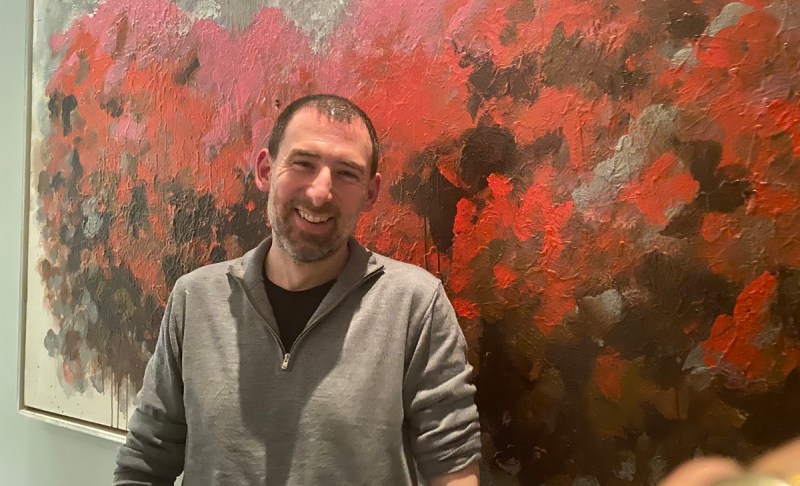
Above: James Gwertzman is general manager of Microsoft Game Stack.
James Gwertzman: I was at Popcap in China for a while, doing free-to-play. I was at EA for a while after Popcap was acquired. I’ve been around gaming for a while. I started Playfab five or six years ago, because I saw the shift in gaming from games as packaged goods to games as services. I saw a need — all my friends who were building games as services had this need for backend server infrastructure. I saw an opportunity. When I was still at EA, they were building a lot of tech from scratch and it often didn’t work very well. I saw an opportunity to build a platform for live games, which became Playfab.
About two years ago, Microsoft acquired Playfab, because Microsoft was starting to realize that the cloud was more and more important for game operations. Given that Microsoft has Azure and a 30- or 40-year legacy for making games, we had an opportunity to take a bigger role in providing cloud services for the game developers. Playfab came in. Now that we’re two years into the integration, I’m starting to see more opportunities to try and pull more of these development services into Azure. Going beyond things like hosting multiplayer game servers, but doing analytics and running things like Github. There’s an opportunity for things like passive management. This is an interesting shift going on.
We want to chat about where we think the game industry is going. I’ll share some thoughts I have on what the trends are. But I’m also interested — we at Microsoft are genuinely trying to put our growth mindset on and think about where the opportunities are. Where can we play a bigger role? How can we help? And not just — normally, this is a year when Scarlett is coming, and we’re focused on building the next generation of Xbox. We have xCloud coming. But we’re looking beyond those. Not just providing services for those new devices, but for the broader gaming ecosystem.
With that as the context, I’ll share my big insight. We’ve entered this era that we think of as modern game development. The notion of how you build games has changed. Fortnite characterized games as not just as a service now, but games as a community. The game is a platform, and the kinds of things you do in games are shifting. It’s not just playing anymore. It’s dancing. It’s buying things. It’s competing and streaming. The nature of gameplay has changed.
To kick things off, where do you see–how is the role of the game developer changing? How are games themselves changing? What are the next big ways in which games are shifting? Later we can talk about what the changes in the development process look like to make that possible. But I’ll start with that. How are games changing?
Discoverability is a huge problem
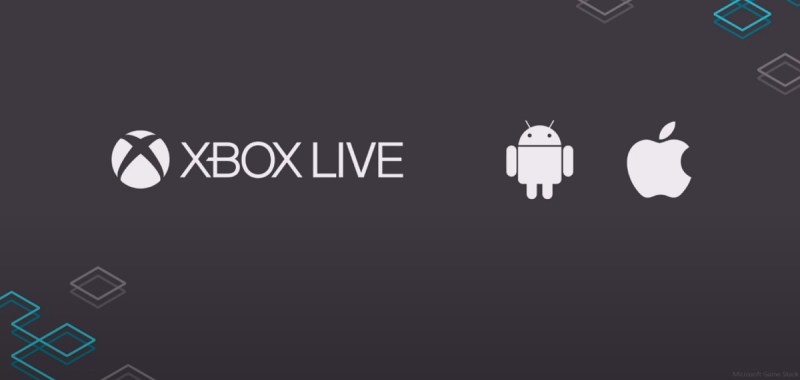
Above: Xbox Live is coming to iOS and Android.
Journalist: All I know is, every game developer I talk to is very concerned about making sure their game gets noticed. More than anything else in the last five years, the one thing that everyone is now more concerned about than ever is discoverability. How are they gonna get the word out? How much visibility can they get? How long do they have before they get buried and have to start cutting prices? I know you offer analytics and all kinds of stuff, but from where I stand, that’s the number one concern when it comes to the next generation of tools and services.
Gwertzman: Player acquisition and discoverability, yeah.
Journalist: Everything you can do outside the storefronts themselves to help them better understand where to best spend their time and money to get sales. There are so many games, and at this point there are so many audiences, that you know there’s a way. There’s enough of an audience for your game. You just have to get it in front of people who will buy it. That’s where they always run out of money, before they find it.
Takahashi: That’s why Unity bought all those services companies, to offer that on top of the game engine.
Gwertzman: I hear the same thing. I also hear a lot about the cost of acquisition, paid performance marketing. I also hear a lot of developers who don’t know how to do that. To them — how do I buy ads? How do I buy gamers? It’s a very scary thing that they don’t know how to do.
Microsoft’s goals in gaming
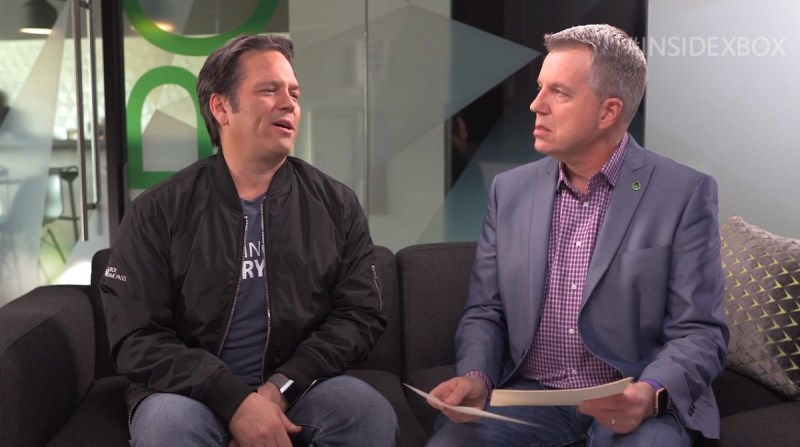
Above: Phil Spencer and Larry Hryb
Journalist: When you interpret what Satya and Phil Spencer are saying, how much of this do they want to enable? They’re much more open than the previous generation, but do they see a path to being really open, but also beating the hell out of Sony? Is there a trade-off?
Gwertzman: It is schizophrenic. Phil says, over and over again, that we in the gaming division need to find a way to reach the 2.8 billion gamers in the world that we believe there are. That’s a number that you hear over and over again in internal meetings. 2.8 billions gamers in the world, and we need to reach them all. We acknowledge that we will never reach more than 100 million of them by selling them an Xbox. The only way to reach the remaining 2.7 billion is something else, whether it’s xCloud or things like Playfab, where we’re not reaching them directly, but we’re providing technologies to help reach them. Or Azure, or something.
We don’t have a phone anymore. That didn’t work. Microsoft is not in the phone space. We don’t have a consumer phone offering. But we nonetheless aspire to be relevant. We think a lot about that.
Journalist: I do think that this is going to be a key point in the next generation. We’re already seeing the boundaries collapsing. I’m of the opinion that within a year or two, we’re going to be playing Game Pass games on the Nintendo Switch. We’re going to have MLB The Show on Xbox Series X. In 10 years, all of PlayStation and Sony and maybe even Nintendo — there might still be hardware, but effectively you’re all becoming service providers.
Gwertzman: Let me turn that around. If you were Microsoft, and you had a device like an Xbox, what would your strategy be? Would it be to build a wall around it and go for exclusive content? That’s certainly what the streaming services are doing. Netflix and Apple and CBS all compete by having exclusive content. They’re not all trying to serve the same content. Gaming, because it’s interactive, offers the possibility of shifting that, where it’s not just the content that makes you unique. It could be the community. It could be your safety. It could be the lack of toxicity. There are lots of factors that might make your service different from someone else’s service.
How can Microsoft win in games?
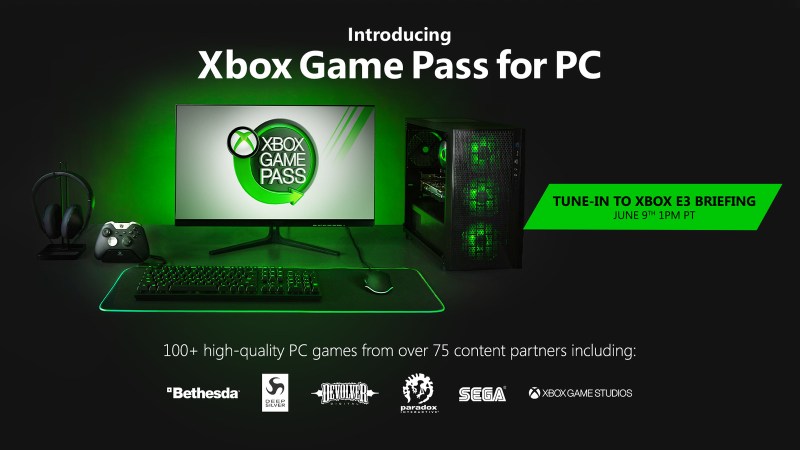
Above: Microsoft’s expanding Xbox Game Pass with around 50 games and new bonuses.
Gwertzman: My question would be, what would you do? Would you go for exclusive content, or do you see other ways to make your X better than the other guy’s X?
Journalist: I think Microsoft is trying to beat everyone to the punch with the all-encompassing service that gives people as many games as they can possibly digest, on as many platform as they possibly can. And then Sony or Nintendo inevitably play catch-up. Or Google. Google already tried to beat you to the punch, but they haven’t been doing so great. I think Microsoft has very clearly seen that — I’m telling you what your business model is. But I think Microsoft has seen that the business model going forward is Game Pass. You need to get Game Pass on as many platforms as possible. It’s not a bad plan, honestly.
Gwertzman: Game Pass is important, no question about that. That’s a key part of our strategy. It’s funny, because — again, I sit in a world where, if Game Pass is a consumer offering, I look at, what is the developer offering? How do we make Azure, Playfab, Microsoft compelling for developers.
Unity, arguably, is the one thing that every developer uses. It’s either Unity or Unreal now. They’ve been very effective. But both of them are struggling in the cloud. Unity has done a lot of acquisitions, but they haven’t really made it through yet, and they don’t have their own cloud. There’s this question of what the thing for developers looks like. How does that — how do we unleash creativity? How do we move the industry forward, and at the same time, build the business?
Takahashi: I don’t think Sony and Nintendo should be Microsoft’s concern. I think it’s more the big guys. It’s Amazon. It’s Google, Facebook, and Apple. Amazon is the most dangerous, with Amazon Prime. Ask for $10 a month and throw everything into it. They have Twitch Prime.
Journalist: And they’re trying to put games on Fire TV.
Takahashi: Well, Fire TV I’m not worried about. But it feels like the things you need to do to compete with something that’s $10 a month, or free in Google and Facebook’s case — that’s what Microsoft needs to worry about. How do you structure the game business to recognize that? That’s the real enemy. Game Pass is very important, making sure it gets all the traction toward getting Microsoft its subscriptions every month.
Gwertzman: In the world of Game Pass, one of the things I’m personally involved with right now is helping on the PC side. Microsoft announced PC Game Pass, and it turns out that when we’re trying to get games onto PC Game Pass, the biggest challenge is actually — all these games were built for Steam. There’s a bunch of entrenched technology there. One of the biggest requests I got at GDC last year from developers was about helping them get off of Steamworks. They want to be on the Epic store. They want to be on the Discord store. They want to be on Game Pass. But they have a hard dependency on Steamworks. They need an alternative open platform version that will work across all of the above. I started hearing that about a year ago at GDC.
My interpretation of that is that for developers, for a long time Steam was the PC store, full stop. There’s enough competition now that people are looking for cross-platform, open alternatives that will work with Steam — because that’s still important — but will also allow them to work with these other things. That’s not a secret. That’s something we’re very much thinking about. How do we make services that will work on all different platforms? That will work on Steam, but also Epic and others. Things you can use for chat, for multiplayer hosting, for buddy lists, for identity, for analytics and so on.
The game developer as nightclub impresario
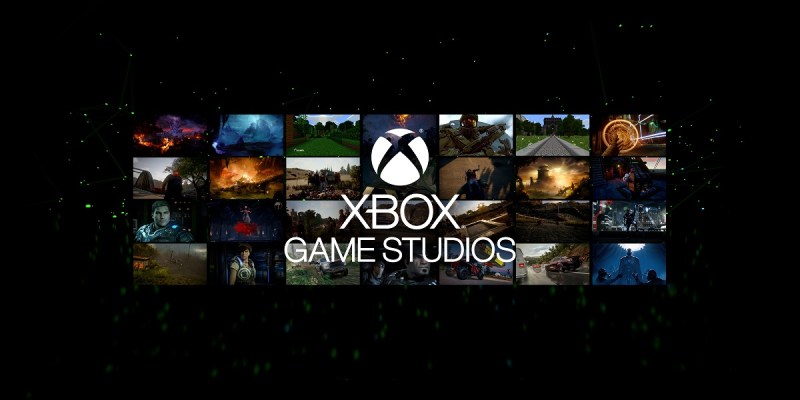
Above: Xbox Game Studios is the new name for Microsoft Studios.
Journalist: One of the things that, talking to — especially indie, large indie to small indie developers — the feeling I get is that a lot of people feel like the live services game trend. A, there’s only a limited number of slots for large live games to succeed, and B, there’s not a lot of — it’s just the latest fad. If you look at all the people that chased MMOs around 2004, and the people who chased Call of Duty, 80 percent of those, even the fast follows — Fortnite is the exception in the battle royale space. But people are leading the other way and going more to something like Untitled Goose Game, making smaller, more manageably budgeted games that don’t require massive online services.
Journalist: You must hear this better than any of us. I talk to devs and I hear that it’s hit or miss to get noticed. But you must work with devs who manage live games of all scopes and sizes.
Gwertzman: I see a skewed view of the world. You’re right. We talk predominantly to devs who are doing live games. The view I have is games that are — people who want to go live, and they — the thing about live games is it pretty radically shifts the production process. Even Microsoft, our first-party studios are trying to figure out how to build games as services now. Halo is trying to figure out what that looks like, for example.
Building a game as a service — we’re seeing it’s not only a change in the technology. It’s a change in the production process and a change in the studio mindset. That mindset shift is the hardest of all. It can take five or six years for an entrenched studio to change the mindset around development. It’s no longer about having a big idea and putting it out there and the players will like it. It’s more about — it goes from game designer as movie director to game designer as nightclub impresario. Now the game is an opportunity for players to meet each other. The game is an opportunity to have meaningful player interactions. You’re designing very differently when that is the goal versus when you have a story you want to tell or a vision you want to share.
Journalist: Sticking with the nightclub metaphor, it’s a chance to bring in outside acts. Fortnite brought Star Wars in for a day.
Gwertzman: That’s it. It’s a cabaret, or a cruise ship. You’re constantly reskinning and updating. On one hand, to your point, it’s more expensive and harder, because you have to invest in this continuing operations team. On the other hand, you don’t have to put it all up front. Idle Miner Tycoon is one of the early games on Playfab. They launched after three weeks of development. It looked like shit. But they’d update every week for two years in a row. If you watched the numbers, they clawed their way up. I don’t know, to your point, how replicable the model is. Maybe it’s lightning in a bottle. But they clawed their way to success. Games that get that right can ride that MVP curve up, as opposed to coming out up here and watching your share steadily decline.
Will 5G gaming be a big deal?

Above: Google’s Stadia game controller.
Journalist: Do you think 5G is important in that it will bring more people online, or make mobile connectivity more reliable and fast? People talk about 5G as a game-changer and I just don’t see it.
Gwertzman: I’m not close enough to mobile to know. Personally, I’m not sure either. I’m very interested to know what everyone at the table thinks about 5G. I think 5G for sure will offer lower latency on mobile devices, and it will increase bandwidth. It will do so in parts of the world that haven’t had high bandwidth up to now. Africa, for example, may go straight to 5G. Technologies like game streaming, xCloud or Stadia, may be — this is an open question. Will things like 5G and game streaming converge and open up whole new swathes of the world to prestige or premium gaming that haven’t had that access until now?
Journalist: Do you see at 5G solving one of the infrastructure problems for cloud gaming?
Gwertzman: Yes.
Journalist: You’re banking on that?
Gwertzman: That’s one of the bets. Especially if you can move the game servers to the edge. Instead of having it all in two data centers, if you can put them pretty far out to the edge, in some cases even in cell towers, you can get close to where players are.
Takahashi: Is Stadia going to benefit? Google’s problem right now is Comcast. If they have games that are consuming — was it 100 megabits a minute or megabytes a minute? Comcast is going to complain about that. Here’s your data cap. The players are going to go over it if they play Red Dead Redemption 2 for a while.
Journalist: But that’s bogus. If I download 100 gigs of Red Dead Redemption 2 and play that for 30 hours, it will be way cheaper at a gig an hour of video than it was as a 120-gigabyte download or whatever it was. The amount of data consumed to stream the video for the 10 or 20 hours most people will play the game is way less than downloading the entire game. Assuming you’re not Fortnite.
Takahashi: But then you’re still paying the regular price, as opposed to a subscription for Stadia. If Google can bypass Comcast, it’s a different story. Then Google doesn’t care about data caps. They can afford to make this business model work. 5G gets them into the home and gets them out of the home on a Google-owned network, instead of using Comcast. I think that’s a big deal strategically as far as enabling cloud gaming in homes.
Gwertzman: I think 5G is one of the things that will help with streaming. When the question goes — will it go beyond that? Will it just be more people having access to high-bandwidth mobile, or will it actually usher in whole new types of games? That’s one of my questions. What will emerge that we haven’t seen yet? Will there be more AR games, more cloud-based games?
The game I’m most excited about next year is Microsoft Flight Simulator. I loved Flight Simulator as a kid. On my Apple IIe I was playing Flight Simulator. I haven’t had a chance to get my hands on the new one yet, but I’ve talked to people who have, and they say it’s mind-blowing. You’re flying through real-world conditions, real-world weather. The entire world is satellite mapped. To me, that’s the ultimate cloud game. You’re not streaming. You play on your own device. But the data set you fly through is streamed continuously through the network. That’s cool. I’m very curious about where that trend takes us.
AI’s future in gaming
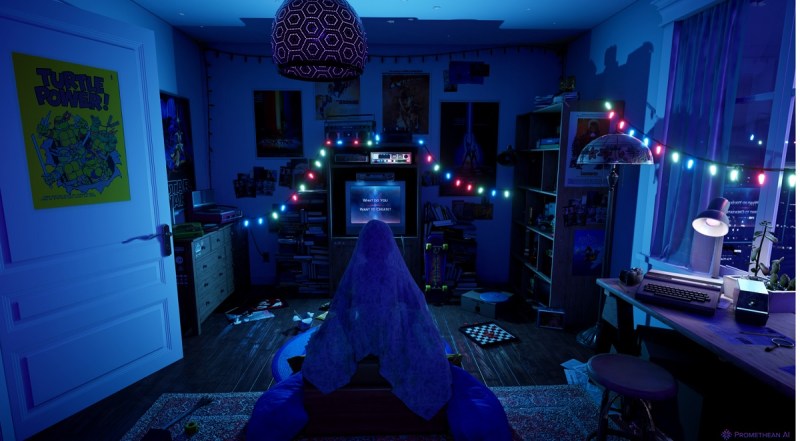
Above: Did a human artist create this scene?
Journalist: The thing I find really interesting is people using AI to remaster games. I think that will be something I see a lot more in 10 years. In 10 years I fully expect that we’ll have AI editing our videos and editing our podcasts. It’ll completely change a lot of how we consume media. It’ll make things easier, but also take away a lot of the specialization. I think you’ll see that in game development as well. AI will be a big part of that. That will play into a lot of what we’re talking about around forwards compatibility.
Journalist: It’s interesting, because people are already doing stuff that’s kind of like that video editing example. There are services that connect to game APIs and Twitch APIs to know you were streaming at this time. You got kills at these times, so here’s your highlight reel for the night of all the people you killed in Fortnite. Which is just bananas. Following you around and making your own personal edit reel.
Journalist: We’ve known for years that game development is becoming more and more procedural, which is wonderful in a lot of ways, because it’s so much more — you have small teams creating incredible worlds. But also, at some point, you’re probably not going to need as many landscape designers. Like No Man’s Sky. There will be new roles, new AI wranglers.
Gwertzman: You were saying that the biggest challenge is acquiring new players. When a three-person team, through procedural generation, can make a game that seems like it’s epic scale, that makes it even harder now. Even more games are coming out that reach that bar.
The power of the cloud
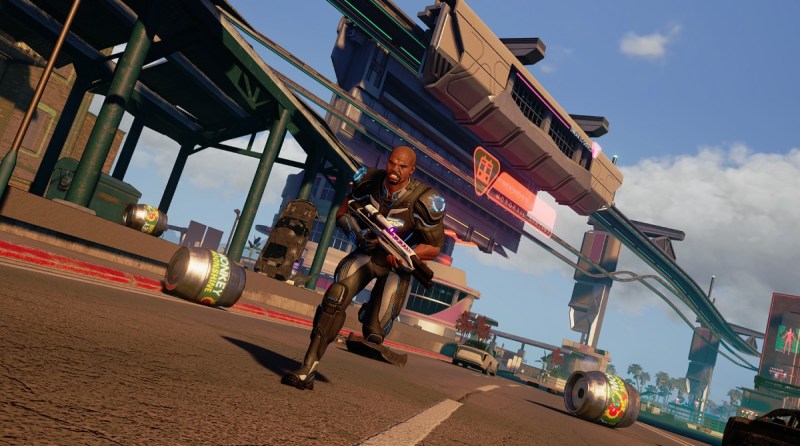
Above: Crackdown 3 lets you roam the city as an agent of destruction.
Journalist: One thing that’s interesting to me, and the web people — game people have been doing this for a long time, ahead of traditional apps and web. The decreasing cost of the cloud — you guys talked about that a lot in the last generation at Microsoft. It kind of flopped spectacularly, because I think people didn’t know what to do with it. But I still think that there’s a massive potential for people who are building games to apply, essentially, free compute. Maybe it’s not to — what was the example, the Crackdown building deformation? But to allow people to spin up small instances like you do with Minecraft now. I can have a private world where we can all hop in together and do Minecraft stuff.
Gwertzman: Minecraft Realms does that. Minecraft Realms is actually powered by Playfab. My team helps support that. I love that we can now essentially rent servers to consumers as part of a built-in business model.
Journalist: In-app is the key. You don’t have to go to some weird webpage.
Gwertzman: Right. You just turn it on and boom, you have your own server. I actually wonder about that. One of the things companies like Improbable are talking about — games can have a million players concurrently in the same world. I don’t even know if people want that. I kind of think the 100-player limit in Fortnite feels like it fits a sort of — it’s a magic number. That’s the right number of people to engage with. 10,000 people on a server would actually not be manageable.
Journalist: I often feel like it’s just another one of those things where we have the tools, but we don’t know what to do with them yet. So many people are trying to — I don’t know if you remember Shinra. But trying to reach out and touch the majesty of distributed computing — we can do a 10,000-player game, why not? But that isn’t actually really that good. What kind of game could you make with 10,000 clients? That’s what I’m excited to see in 10 years.
Gwertzman: That’s a question we really need to tackle. Who will tap into — one of the technologies my team is looking at now is serverless multiplayer games. Why do you have to build a server, a game that’s hosted on a physical server, and we have to spin that up? Why not give us the logic and we’ll spin up whatever you need to support that?
Journalist: Because home routers are terrible.
Gwertzman: Yeah, yeah. But we can move a lot of logic — if there’s a demand for that, we can do that. We can say, just give us logic and we’ll magically power it. But then that opens the question of what we do with that. What kind of game experiences will that power?
The cloud is interesting. I first discovered the power of the cloud, ironically, at Playfab, where my engineers were building servers that — we had zero downtime updates. Instead of the old-fashioned model where at midnight on Sunday you take everything down to update, now we would just spin up completely separate instances of everything, slowly move the traffic over, and then take down the old version. It made it easy to spin up things and spin them down. That, to me, was the real power of the cloud.
Now we’re starting to look at things like asset management. If data and assets are the hard, expensive thing, do you move the editing tools to the cloud and do your editing in the cloud, where the data is, versus doing it in a local machine and bringing the data down to the local machine? Especially with massive data sets. The data analysis, obviously. PlayFab today is handling hundreds of thousands of events per second for some games. That all goes in a giant data lake somewhere. Maybe the designers are analyzing it to figure out player behavior and trends and so on.
People are still taking the baby steps as far as what to do with these technologies. That’s one of my big open questions. What can we do to help? Where are the pain points and where do we see the opportunities to add value and help developers, versus simply making them feel even more stressed out by even more things they have to figure out?
Fighting toxicity in games
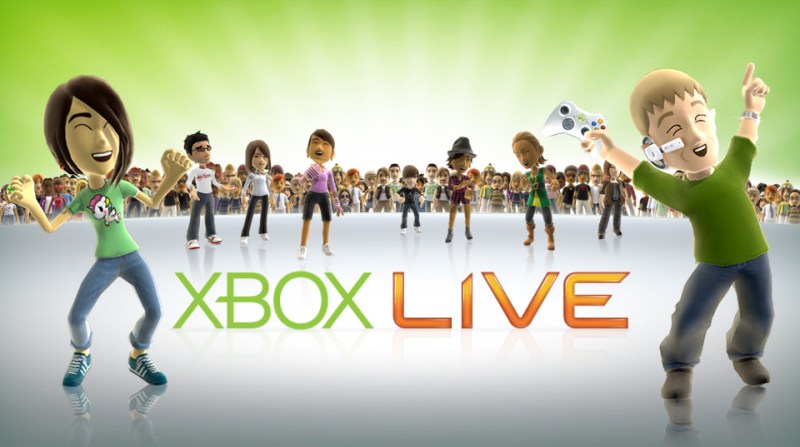
Above: Xbox Live.
Gwertzman: We were talking earlier about player data. What are the threats to gaming? The New York Times ran the big article a couple weeks ago about toxicity in games, about grooming and people being harassed. Harassment in games has been acknowledged, but unsolved for a while. Now we’re adding trafficking and other problems on top of it. How do we feel like the game community — are we rising to the challenge? Is it getting worse? Do we feel like that’s an existential threat, or is it just accepted as something that goes along — that anything on the internet has these kinds of challenges?
Journalist: From the game devs I talk to, it really depends on who’s running the forums and who’s designing the game. I’m endlessly surprised by how well teams who practice good community management and really proactive anti-toxicity design can make a big difference in their games.
This is probably a bad example, but I really loved Kind Words last year. The Popcannibal game. That’s a game that has very subtle anti-toxicity systems in the backend that are very hard to get to. They trust the players to not be terrible. So far it seems to be working. That’s a really beautiful — it gives me hope for, in the future, devs being able to build that and continue to cultivate audiences that are not jerks.
Journalist: On the other hand, every major online game has a way to turn off the other player names. You don’t have to see the creative ways that people get past whatever filters might exist.
Journalist: It seems to me that the problems with toxicity in video game online communities are part and parcel of toxicity issues on social media.
Journalist: It’s the internet, right? It doesn’t have to be, but it’s the way the internet has evolved.
Journalist: There was an interesting — it was a thread about an open source project that just said, look, our community has gotten really toxic. We either have to live with having these horrible people representing us to people who come in with problems, or we have to burn it all down and start over. They did that and immediately got five times the engagement they had before. They burned it down and started over, and it dramatically improved the experience. They started over with the rules they should have set. It’s not unfixable.
Gwertzman: Xbox Live, we spend a lot of money policing Xbox Live. We see that as a competitive advantage, so Microsoft puts a lot of resources into it. Entire teams of people moderating and managing it. One of the questions now is, is that one of the services we should be offering? Should we offer moderation or anti-toxicity services that we use internally for Xbox Live and turn that into one of the technologies we expose to the world? They go beyond just profanity filters. It can go into things like Community Sift, a third-party company that we partner with that helps provide some of the technology.
Journalist: Is that some kind of moderation service?
Gwertzman: Community Sift is one of the leaders. They’re a Canadian company that grew out of Club Penguin. They started initially doing advanced bad language filters. Now they’ve gotten pretty sophisticated. They can look for grooming behavior and all sorts of things. They don’t say yes or no. It’s not binary. They score things. As a game developer you can take those scores and use them to create player profiles. Okay, this player is probably someone I should think about banning or segregating or otherwise doing something about.
Journalist: They can put people in buckets. This person uses bad language, but not ethnic slurs.
Gwertzman: Right. As Playfab, we think a lot about that. Do we make it easy to put all your trolls playing with each other? Versus your younger kids who are under 13. Don’t let them play with the trolls. You can do that kind of thing.
The future of games at Microsoft

Above: Xbox Series X width.
Journalist: If you want to talk about the larger point of where games are going, I’m going to rewind a bit. I think the question I have for Microsoft is, what is Xbox? There’s been a lot of rumors over time. Everything from, Microsoft is going to get out of games entirely, to Microsoft is going to compete directly with Sony, to Microsoft wants to be a live services provider. My personal view is that Microsoft is trying to get back to its roots, in a way. It’s always been an enterprise software service provider. Creating something like Game Pass is getting back to that. I’m curious what your take is, because I think Microsoft’s main objective will say a lot about how games change in the next two years.
Gwertzman: I can only answer from my perspective, which is, Microsoft is so big that there are a lot of businesses that are equally valid. Gaming and the Xbox is one of Microsoft’s last great consumer businesses. A lot of people are working on Scarlett or things like xCloud who feel almost a sacred responsibility to maintain this consumer business that’s one of the last places we’re doing that.
It’s frankly a very healthy business. We’ve figured out how to make it profitable. We’ve acquired a lot of studios. We’re in gaming for the long term. But independently, where I set is more to your point about Microsoft’s roots. Microsoft started, it’s important to remember this, started out as a language company before we were an operating system company. Microsoft BASIC was our first big product. We licensed it to Apple and Commodore. We were a developer tools company before we were ever a consumer operating system company, and long before we were an office productivity company.
Going back to those developer roots, that’s where I set. How do we help developers? How do we help developers figure out the cloud? How do we help them figure out acquisition and performance marketing? Microsoft has evolved into all these businesses now. I look at things like Dynamics. Dynamics is Microsoft’s competitor to Salesforce and SAP. How do we partner with our Dynamics team internally so that if you’re operating your company with our enterprise ERP package, your games can talk to it seamlessly and you have better correlation? There are interesting opportunities there.
One of my questions, let me open this to the whole table. One of the things Microsoft can do, we’re such a big company. We can provide the leadership in areas where it’s needed. So where is leadership needed? Where can Microsoft help the industry by either taking a stance or creating a standard or open sourcing key technology? What are some examples of where that would be helpful to the industry?
We have this thing called Game Stack. Game Stack is our umbrella marketing term for all of Microsoft’s game technologies. It’s more marketing right now than product reality, but a lot of people are working hard to make it a reality. How do we provide a bunch of technologies that work together seamlessly to help operate your game?
Acquisition is not — we don’t really have a thing in the acquisition space. We don’t have Adjust or Appsflyer or one of these acquisition tracking companies. We also don’t have Facebook or Twitter. We do have LinkedIn. We do have Bing, for what it’s worth. Are there ways we can leverage those to help with acquisition?
Developing games for the next generation machines

Above: Xbox Series X.
Journalist: How hard is game development going to get for the next generation? For PlayStation 5 and Xbox Series X? The big problem in the past was when you had to switch to a new chip, like the Cell. It was a disaster. PlayStation 3 development was painful and slow. It took years and drove up costs. But since you’re on x86, it shouldn’t happen, right? A lot of those painful things go away because it’s just another faster PC. But what’s going to be hard? What’s the next bar that everybody is going to shoot for that’s going to give them a lot of pain, because they’re trying to shoot too high?
Gwertzman: You were talking about machine learning and content generation. I think that’s going to be interesting. One of the studios inside Microsoft has been experimenting with using ML models for asset generation. It’s working scarily well. To the point where we’re looking at shipping really low-res textures and having ML models uprez the textures in real time. You can’t tell the difference between the hand-authored high-res texture and the machine-scaled-up low-res texture, to the point that you may as well ship the low-res texture and let the machine do it.
Journalist: Can you do that on the hardware without install time?
Gwertzman: Not even install time. Run time.
Journalist: To clarify, you’re talking about real time, moving around the 3D space, level of detail style?
Gwertzman: Like literally not having to ship massive 2K by 2K textures. You can ship tiny textures.
Journalist: Are you saying they’re generated on the fly as you move around the scene, or they’re generated ahead of time?
Gwertzman: The textures are being uprezzed in real time.
Journalist: So you can fit on one blu-ray.
Gwertzman: The download is way smaller, but there’s no appreciable difference in game quality. Think of it more like a magical compression technology. That’s really magical. It takes a huge R&D budget. I look at things like that and say — either this is the next hard thing to compete on, hiring data scientists for a game studio, or it’s a product opportunity. We could be providing technologies like this to everyone to level the playing field again.
Journalist: Where does the source data set for that come from? Do you take every texture from every game that ships under Microsoft Game Studios?
Gwertzman: In this case, it only works by training the models on very specific sets. One genre of game. There’s no universal texture map. That would be kind of magical. It’s more like, if you train it on specific textures and then you — it works with those, but it wouldn’t work with a whole different set.
Journalist: So you still need an artist to create the original set.
Journalist: Are there any legal considerations around what you feed into the model?
Gwertzman: It’s especially good for photorealism, because that adds tons of data. It may not work so well for a fantasy art style. But my point is that I think the fact that that’s a technology now — game development has always been hard in terms of the sheer number of disciplines you have to master. Art, physics, geography, UI, psychology, operant conditioning. All these things we have to master. Then we add backend services and latency and multiplayer, and that’s hard enough. Then we added microtransactions and economy management and running your own retail store inside your game. Now we’re adding data science and machine learning. The barrier seems to be getting higher and higher.
That’s where I come in. At heart, Microsoft is a productivity company. Our employee badge says on the back, the company mission is to help people achieve more. How do we help developers achieve more? That’s what we’re trying to figure out.
Making next generation art
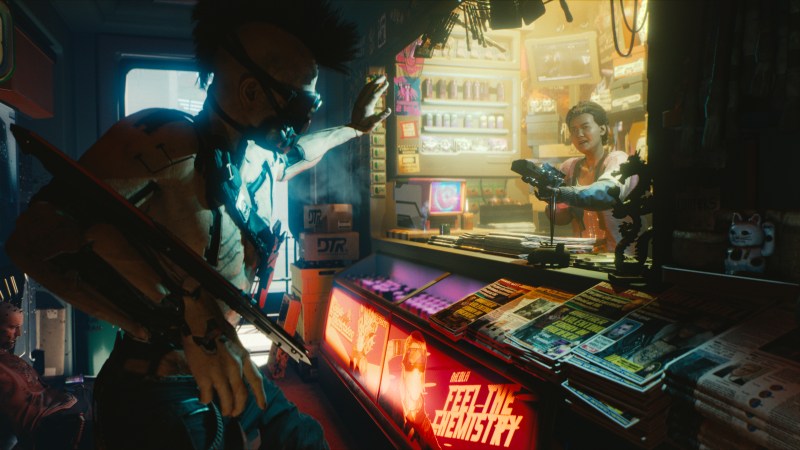
Above: Cyberpunk 2077.
Journalist: You touched on this, but are you projecting that studios are going to increase art staffs to meet the demands of the new consoles?
Gwertzman: I don’t know. I know that every previous generation of consoles, everyone bemoans the fact that art staffs have to go up and the economics just don’t support that anymore. I don’t know that I’m hearing a lot of complaints about that now.
Journalist: A lot of people have been generating stuff for 4K on PC for a while now.
Gwertzman: I’m not hearing a large — are you guys hearing a hue and cry about concerns of producing next-gen games? I’m not.
Journalist: Maybe if you’re CD Projekt.
Journalist: Ubisoft explicitly said….
Journalist: Yeah, but they have 50 teams around the world.
Takahashi: You have Rockstar.
Gwertzman: The new Xbox console, if you look at where the investments went for our new console — we’ve talked publicly about this. Nothing I’m sharing here is private. But the actual graphics performance is not that crazy an increase. It’s 4X or something. Its hard drive speed, and the fact that we have an SSD now, means that data access is 10X faster. The biggest differences are things like data access, and maybe network latency. It’s not about the raw graphics pipeline anymore. I do think the emphasis is shifting a bit. Raytracing is another thing now. That’s more about rendering path. It’s not necessarily about art production.
Journalist: It accelerates the way devs are already going into live games — the default is live games now. Or I shouldn’t say that. For a lot of devs, it’s whatever their dream game happens to be, But for a lot of teams, the way the business is going is live games. Once you have a broad customer base that can pick something whenever they feel like it, grab it and try it, then the new updates, new whatever, become so much more important. You don’t have to worry about having the game installed. Oh, yeah, I love that game, I’ll check it out again. It just steamrolls that whole process.
Gwertzman: That’s something I think about a lot, which is player engagement. The magic word these days is we’re entering the experiential economy. Every business I talk to — Playfab often gets pulled into conversations with hotel chains or travel companies, where they’re looking at how to apply lessons from live games to the retail economy or something like that. It’s not just gamification, which has sort of had its day. This is more about experiences from these always-on live games.
There’s this interesting idea that, if you have — a live game is essentially about player engagement. How do you continually engage your players in a very active way? That’s no different than the “digital feedback loop” you hear about in the enterprise space from Microsoft. How do we gather data, analyze it, and change your experience on the fly based on what you’re doing? If every game is competing with Disney+ or Netflix or Peloton or something, if we’re all competing for people’s attention, you have to connect that feedback loop tighter and tighter.


